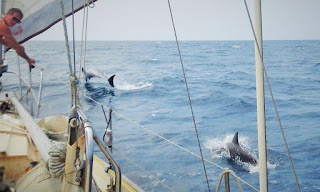Typical trading vessel
Upon checking in, we were issued with "shore passes" so that we could visit the City of Djibouti, a large city with few pleasing features. The Visa and shore pass costs made this short stop expensive but we needed to top up on fuel and stock up on some groceries, especially fresh produce, plus we wanted to see the City.
We found the clothing bright and the mix of colours and patterns not necessarily matching. Even the traditional burquas, commonly just black, were colourful. A nice change. With few exceptions, men wore long pants but however we did see young boys wearing shorts.
We quickly learned that there were some sneaky tactics employed by some to part the dollars from us boaters. A typical tactic is an insistent helpful hand that in the end turns into an intimidating demand for money.
The other tactic we experienced was, without a shred of shame, a demand for more than an agreed price at the end of our taxi ride. A crowd had gathered to watch the showdown as Jordan had a real face-off, nose-to-nose, with our taxi driver who finally gave in to the original price after we started to walk away without any payment.
The buses were more fun and more welcoming and of course much cheaper. Like taxis, they were decorated with a faux fur dashboard cover - that had seen cleaner days - and a frilly cloth or vinyl trim around the outside mirrors, in a lame attempt to make it look like a flower blossom.
We were advised not to purchase a SIM card as internet was extremely slow, if it worked at all. So we trotted off to a major hotel to use their free WiFi and email family and friends. But at $10 per coffee, it negated the bonus of free internet. We have found Djibouti to be extremely expensive; a real culture shock after the affordable Asian countries.
Djibouti is now an independent country but was once a French Republic. Some still speak French and the Franc is used as their currency. Jordan was dreaming of delicious French pastries, but alas, none were to be found.
There were two distinct places to shop. One was a clean and modern supermarket with many imported western products priced almost twice what we would pay in Canada. In contrast, was the open air fruit and veggie market where the shelves were well stocked and where goats scavenged through the trash.
HOW much did you say!
At the market, we were able to find people who were willing to have their photo taken, whereas most others we encountered in the City turned away when a photo was requested. Big smiles were received when we showed them their photo on the camera.
Show me my picture!
Busy tossing her seeds
I managed to sneak a photo of this poor young girl who would hold out her hand for money. Begging was not an uncommon practice wherever we went. Avoiding eye contact limited those encounters. Distressing, as this is an expensive country for poor people to live.
Can you spare a Franc?
Djibouti is a city in contrasts. You have abject poverty somehow co-existing with a flourishing international business. Some make no qualms of blatantly overcharging to the point of ripping you off, however, theft is unheard of. Older money-changing ladies sit on the sidewalks with bags of money with no worry of theft.
After two days and in a weather conference with the other sailors, we thought it best to head out and into the Red Sea. It was best summed up in the conversation by two of us: "Djibouti has lost its charm." The other responded, "I didn't find any charm to begin with."











































